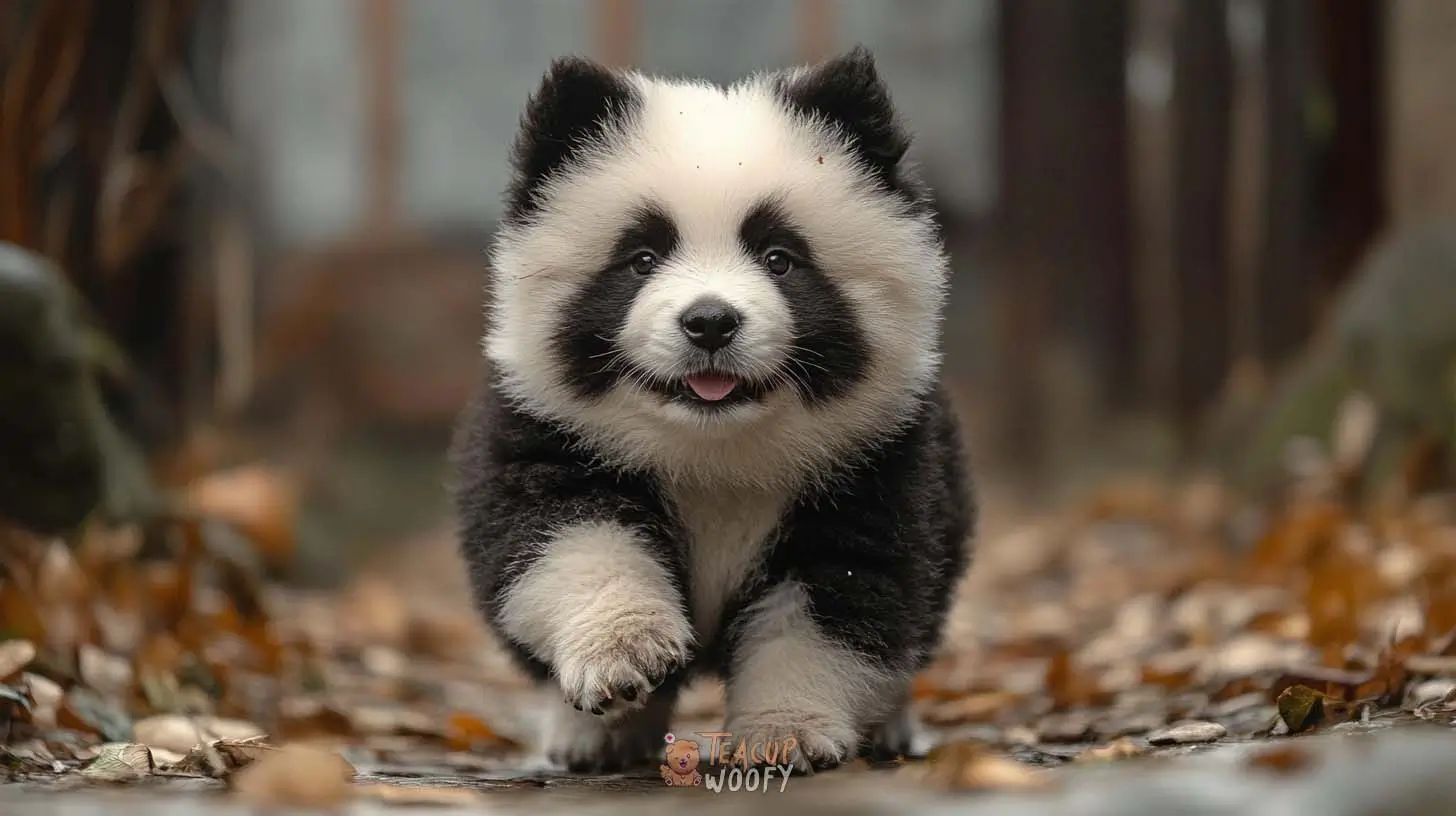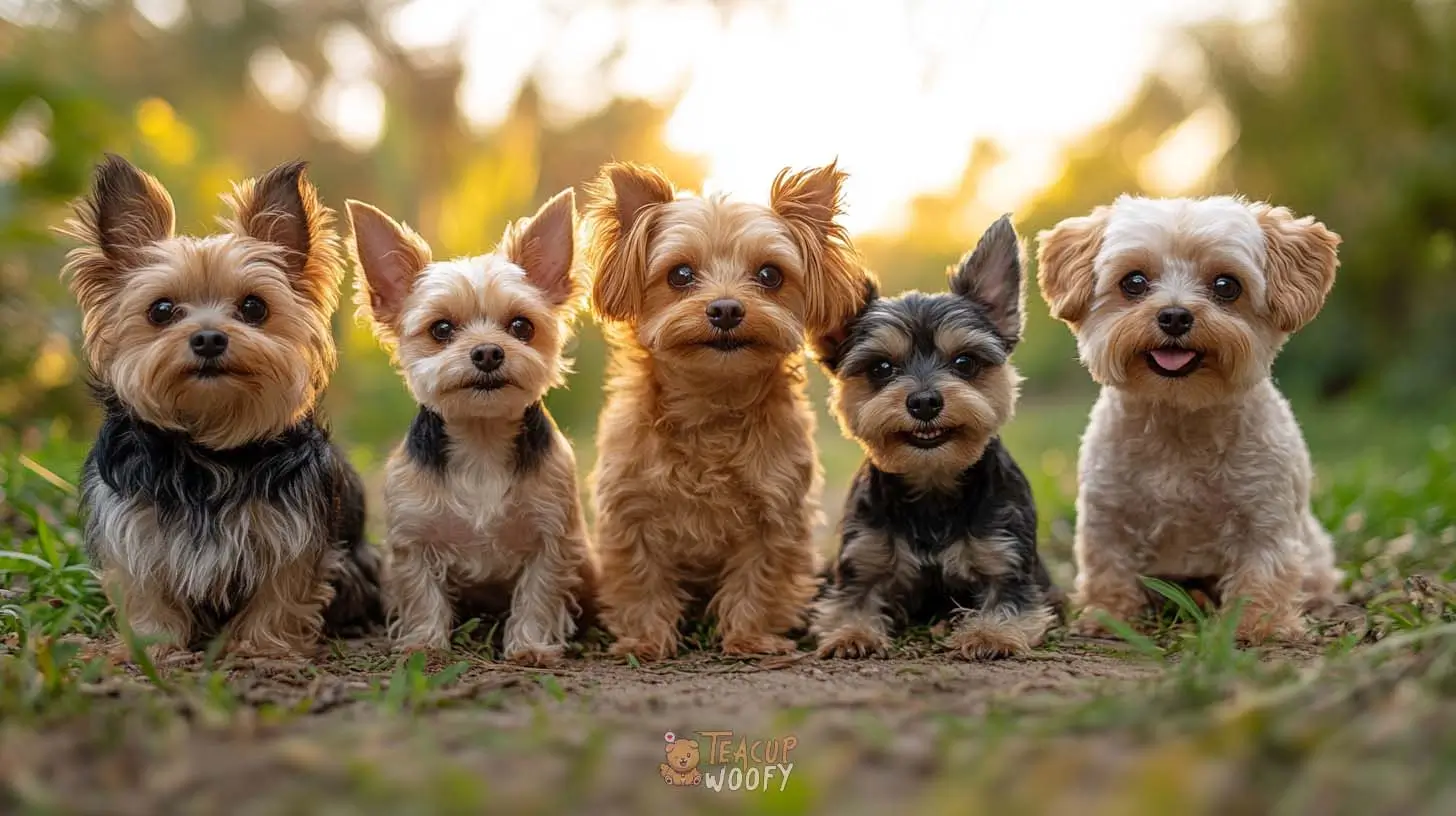Okay, let’s chat about the teacup Chow Chow. Picture a classic Chow Chow, you know, the fluffy lion-like dog with that serious teddy bear face, but now imagine it in a pint-sized version. That’s what people are raving about when they talk about a teacup Chow Chow.
I’ll be real with you though, this “teacup” version isn’t officially recognized by the American Kennel Club (AKC). Breeders make them smaller by pairing runts of the litter or mixing with smaller breeds, which means they’re extra adorable, but also sometimes prone to health issues. According to the American Veterinary Medical Association, smaller breeds bred this way often face higher risks of heart problems, bone fragility, and shorter lifespans (AVMA, 2023).
Still, people can’t resist them. Their tiny size makes them feel more manageable in an apartment, and with that big fluffy coat, they look like little stuffed animals that walked out of a toy store. I’ll admit, if one waddled past me at the park, I’d be squealing like a kid.
So, if you’re dreaming of owning a teacup Chow Chow, just remember: it’s all the same dignity and loyalty of a standard Chow Chow, but in a smaller, sassier, and sometimes higher-maintenance package.
Origin & History of the Teacup Chow Chow
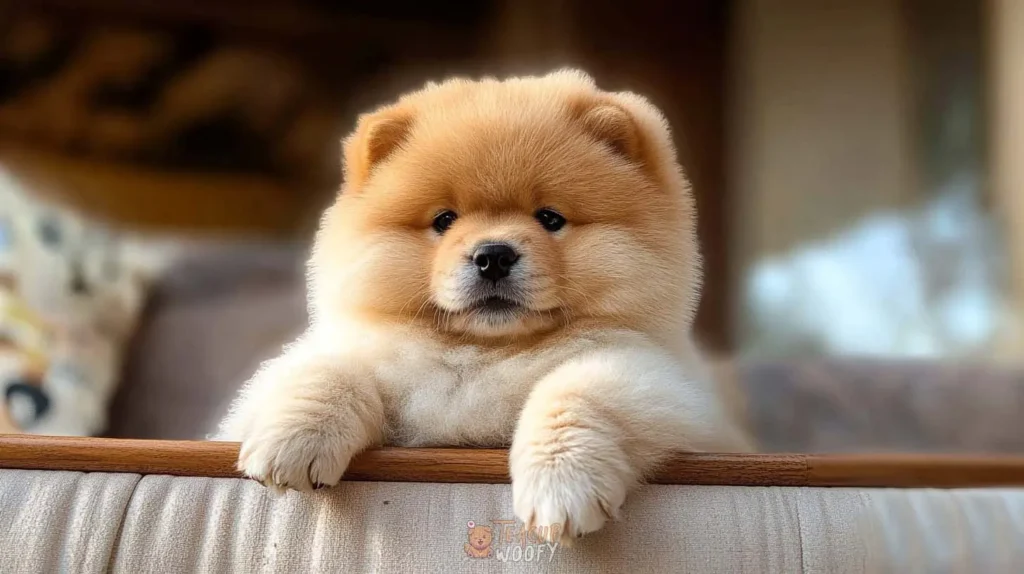
So here’s the scoop: the teacup Chow Chow doesn’t exactly have an ancient origin story like the full-sized Chow Chow. The traditional Chow Chow is one of the oldest dog breeds in the world, dating back over 2,000 years to northern China. They were once palace guard dogs, hunting companions, and even cart pullers. Fun fact, historians believe they were kept by Chinese emperors and often referred to as “Songshi Quan,” which translates to “puffy-lion dog”
Now, the teacup version? That’s more of a modern-day invention. Breeders in recent decades started selectively breeding the smallest Chows or mixing them with smaller breeds to create a downsized version. The demand really came from city folks who loved the Chow’s look and personality but didn’t have the space (or patience) for a 50 to 70-pound furball running around their apartment.
Because of that, the teacup Chow Chow doesn’t have centuries of history like its big cousin. Instead, it’s part of the “designer dog” trend, where people are after miniature versions of already-loved breeds. And let’s be honest, once you see those tiny lion-like faces, you kinda get why.
Size & Appearance of the Teacup Chow Chow
When it comes to the teacup Chow Chow, size is the first thing people notice. While a standard Chow Chow can weigh anywhere from 50 to 70 pounds and stand up to 20 inches tall, the teacup version is much smaller. On average, most teacup Chows weigh between 8 to 20 pounds and reach only about 9 to 11 inches in height. Basically, you’re looking at all the fluff, packed into a compact, carry-me-home size.
Appearance-wise, they’re just as striking as their larger cousins. They’ve got that signature lion-like mane around the neck, deep-set almond eyes, and of course, that iconic blue-black tongue that sets the Chow Chow apart from most other breeds. Their double coat comes in the same classic colors too, like red, cream, black, cinnamon, and blue.
One thing to keep in mind: because they’re so tiny, their features can look a little exaggerated. Picture a teddy bear stuffed into a mini frame, adorable, but sometimes breeders push size limits, which can affect bone structure. According to PetMD, extremely small designer dogs often face skeletal fragility and dental issues (PetMD, 2024).
Coat Variants of the Teacup Chow Chow
One of the coolest things about the teacup Chow Chow is that, despite their smaller size, they keep that gorgeous coat their big cousins are known for. Just like standard Chows, teacup versions come in two main coat types:
- Rough Coat: This is the look most people picture, super fluffy, dense, and lion-like around the neck. It’s got a thick undercoat with a straight, coarse outer layer that gives them that teddy bear vibe.
- Smooth Coat: Sometimes called the “short-haired Chow,” this coat is plush but much shorter and lies flat against the body. It still feels soft, but you won’t get the same dramatic mane as with the rough coat.
Color Variants
Teacup Chow Chows also come in the same stunning colors as the full-sized breed. The American Kennel Club lists five recognized Chow Chow colors, and teacups follow suit:
- Red (most popular, ranging from light golden to deep mahogany)
- Cream (almost white and super fluffy)
- Black (sleek and striking with their thick coat)
- Cinnamon (a warm, fawn-like shade)
- Blue (a smoky gray that looks especially unique)
No matter which coat or color you fall for, grooming is a must. With all that fur packed onto a smaller frame, matting and shedding are real issues. Regular brushing and occasional professional grooming sessions will keep your teacup Chow Chow looking like the little lion it’s meant to be.
Teacup Chow Chow Growth and Weight Chart
Since teacup Chow Chows aren’t officially recognized, their growth chart is based on estimates from toy and small-sized dogs, adapted from the standard Chow’s proportions. Unlike their bigger cousins who can weigh up to 70 pounds, teacups stay pint-sized their whole lives. Still, tracking growth is super important to make sure your pup is healthy and not under or overweight.
Here’s a handy growth and weight chart for both male and female teacup Chow Chows:
Male Teacup Chow Chow Growth Chart
| Age | Average Weight | Height (shoulder) |
| 8 weeks | 2 – 3 lbs | 5 – 6 in |
| 3 months | 4 – 6 lbs | 6 – 7 in |
| 6 months | 7 – 10 lbs | 8 – 9 in |
| 9 months | 9 – 13 lbs | 9 – 10 in |
| 12 months (adult) | 12 – 18 lbs | 9 – 11 in |
Female Teacup Chow Chow Growth Chart
| Age | Average Weight | Height (shoulder) |
| 8 weeks | 1.5 – 2.5 lbs | 5 – 6 in |
| 3 months | 3 – 5 lbs | 6 – 7 in |
| 6 months | 6 – 9 lbs | 7 – 8.5 in |
| 9 months | 8 – 11 lbs | 8 – 9.5 in |
| 12 months (adult) | 10 – 16 lbs | 8.5 – 10 in |
Things to Keep in Mind
- Growth slows after 6 months but they’ll still fill out a little until about a year old.
- Teacups can vary depending on genetics and breeding practices, so some may be slightly bigger or smaller.
- Vet checkups are key to make sure your pup’s weight aligns with healthy growth. Small breeds are prone to obesity, and even a couple extra pounds can stress their tiny joints.
According to the American Veterinary Medical Association, maintaining a healthy body weight can increase a small dog’s lifespan by up to 2 years (AVMA, 2023). That’s huge when you’re talking about a breed that already has some health risks due to its size.
When Will a Teacup Chow Chow Stop Growing?
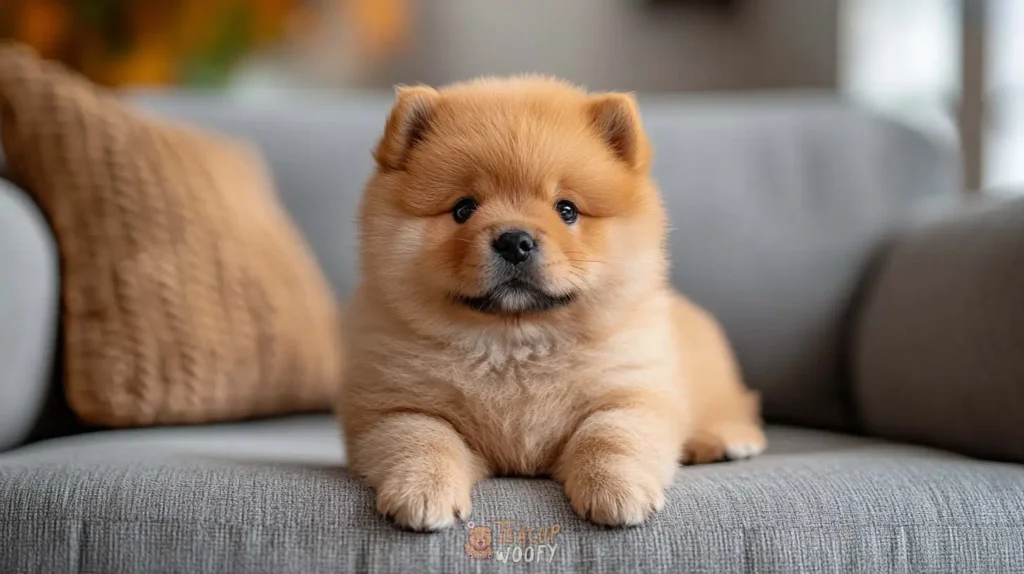
Alright, let’s tackle this one, because I know as a dog owner myself, I used to wonder when will my pup finally stop growing? With a teacup Chow Chow, the timeline is a lot shorter compared to larger breeds.
Most teacup Chow Chows will reach their full height by around 8 to 9 months. After that, they’ll keep filling out a bit, gaining muscle and fluff, until about 12 months old. By their first birthday, they’re considered fully grown adults.
Here’s the general timeline:
- 2 to 3 months: Fastest growth stage, lots of changes every week.
- 6 months: They’ve reached about 70–80% of their adult size.
- 8 to 9 months: Height plateaus, but weight may still increase.
- 12 months: Growth is complete, though some may “bulk up” slightly until 14 months.
For comparison, standard Chow Chows take up to 18 months to finish growing, but teacup versions wrap it up much earlier because small breeds mature faster. According to PetMD, most toy-sized dogs hit their full size before their first birthday, while giant breeds can take up to 2 years.
What Is the Size of a Full-Grown Teacup Chow Chow?
Once your teacup Chow Chow is fully grown, don’t expect a big, fluffy giant like the standard version. These little cuties are bred to stay small, making them perfect for apartments or smaller living spaces.
A full-grown teacup Chow Chow usually reaches:
- Height: about 8.5 to 11 inches tall at the shoulder
- Weight: around 10 to 18 pounds, depending on gender and genetics
That’s tiny compared to the standard Chow Chow, which can weigh 50 to 70 pounds and stand up to 20 inches tall! Despite their smaller size, they still carry themselves with that same proud, dignified stance that makes the Chow Chow look like a little lion.
One important note: keeping them at a healthy weight is so important. Even just 2 extra pounds on a teacup breed can strain their joints and heart. According to the American Kennel Club, obesity in small dogs can shorten their lifespan by several years (AKC).
Teacup Chow Chow Breed Overview
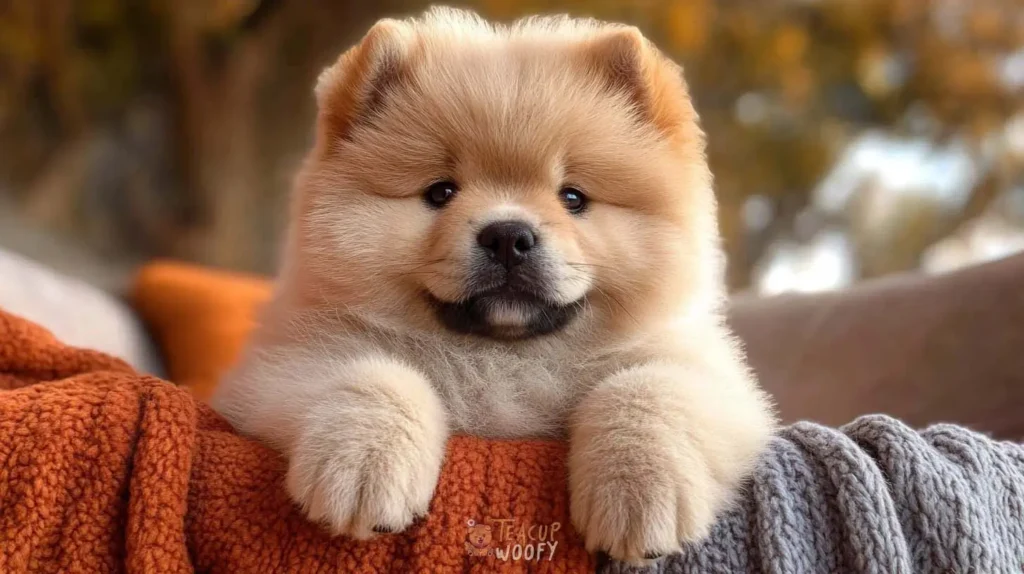
Alright, let’s break it all down into a nice little snapshot of what you can expect from a teacup Chow Chow. Think of this as your quick “cheat sheet” before we dig deeper into each part.
Size
Tiny but mighty. On average, they weigh 10 to 18 pounds and stand 8.5 to 11 inches tall once fully grown.
Group
Not recognized by the American Kennel Club, but teacup Chow Chows are considered part of the toy or companion dog category, thanks to their downsized size and lifestyle fit.
Height
Males: 9 – 11 inches
Females: 8.5 – 10 inches
Weight
Males: 12 – 18 pounds
Females: 10 – 16 pounds
Coat
Two coat types:
- Rough coat: Dense, fluffy, lion-like mane
- Smooth coat: Shorter, plush, and sleek
Coat Colors
- Red
- Cream
- Black
- Cinnamon
- Blue
Lifespan
Around 9 to 12 years. Smaller dogs sometimes live longer, but designer breeding can add health risks, so regular vet care is key.
Temperament
- Loyal and protective
- Independent, sometimes a little stubborn
- Calm around the house, but not overly clingy
- Reserved with strangers but deeply bonded with family
Hypoallergenic?
Nope. With their thick double coat, they shed a lot and are not hypoallergenic.
Origin
The Chow Chow dates back over 2,000 years to China, where they were palace guard dogs and hunting companions. The teacup Chow Chow is a modern adaptation, bred down in size for apartment living and companionship.
Price
Teacup Chow Chows are pretty rare, which means they’re pricey. Expect anywhere from $2,500 to $5,000 USD, depending on the breeder, coat color, and lineage.
Average Monthly Expenses
- Food: $40 – $60 (small dog portions, but premium food recommended)
- Grooming: $50 – $100 (professional grooming every few weeks plus at-home maintenance)
- Veterinary Care: $50 – $100 (averaged monthly for vaccines, checkups, and potential health issues)
- Misc (toys, treats, training): $20 – $40
On average, owning a teacup Chow Chow can cost about $120 – $250 per month, depending on lifestyle and healthcare needs.
Teacup Chow Chow Breed Characteristics
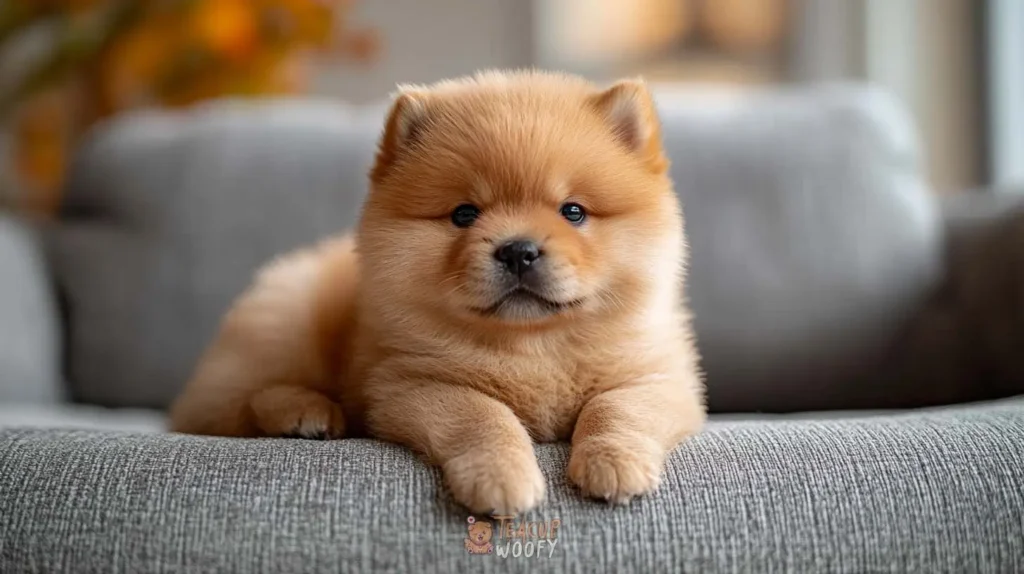
Alright mama, here’s where it gets fun. Let’s dive into what living with a teacup Chow Chow is really like. Think of this as the “personality cheat sheet”, because a dog isn’t just about looks, it’s about how they vibe with your family and lifestyle.
Affection Level
They’re loyal and loving, but not the kind of pup that needs to be glued to your lap 24/7. Expect a dignified cuddle partner who decides when they want affection.
Friendliness
Teacup Chows can be polite with strangers, but they’re not naturally social butterflies. They tend to be reserved and might take time to warm up.
Kid-Friendly
Here’s the deal, they’re better with older kids who understand boundaries. Rough play can stress them out, plus their small bones are fragile.
Pet-Friendly
They can get along with other pets if socialized early, but their protective streak means introductions should be slow and supervised.
Exercise Needs
Don’t expect marathon energy. A couple of short walks and some playtime at home will keep them happy. Over-exercising isn’t safe for their tiny frames.
Playfulness
They’ll play when they’re in the mood, but they’re not as goofy as, say, a teacup Yorkie. Think of them as more of a “let’s chill and play on my terms” kind of dog.
Energy Level
Moderate. They’re not hyperactive, but they’re also not total couch potatoes. They strike a nice balance.
Health
This is a biggie. Because of selective breeding, they can be prone to issues like dental problems, joint fragility, and heart conditions. Regular vet checkups are a must (PetMD, 2024).
Sociability
Early socialization is everything. Without it, they can become overly wary or even territorial. Puppy classes are a lifesaver here.
Trainability
Not gonna lie, they can be stubborn! Patience, positive reinforcement, and consistency are key. Harsh training methods? Forget it, they’ll just shut down.
Intelligence
Very smart, sometimes too smart. They learn quickly, but they also like doing things their way.
Tendency to Bark
Moderate. They’ll alert you if something feels off, but they’re not the type to yap at every leaf blowing in the wind.
Amount of Shedding
Oh mama, brace yourself. With that thick double coat, they shed year-round, and it gets heavy during seasonal changes. Regular brushing is non-negotiable if you don’t want your house covered in fur.
Temperament and Personality of the Teacup Chow Chow
Alright, let’s talk about what it’s really like sharing your home with a teacup Chow Chow. If the standard Chow Chow is known as the “dignified lion dog,” then the teacup version is like that same lion but shrunk down into an adorable teddy bear… with just as much attitude.
Dignified but Loyal
Teacup Chow Chows are not the over-the-top, tail-wagging, “love everyone” kind of pups. Instead, they’re calm, reserved, and often carry themselves like little royals. But once they bond with you, they’re loyal to the core. They’ll follow you from room to room just to keep an eye on their human.
Independent Spirit
Unlike some toy breeds that demand constant attention, these pups enjoy a bit of independence. They won’t mind hanging out on the couch while you’re busy, but they also want to know you’re nearby.
Protective Nature
Even at their small size, the teacup Chow Chow can be a little guard dog. They’re naturally cautious of strangers and can be protective of their family. This makes them excellent watchdogs, though early socialization helps keep that protectiveness from turning into over-suspicion.
Calm, Not Hyper
These pups don’t bounce off the walls like a teacup Pomeranian might. Instead, they’re steady and composed, preferring short bursts of play followed by long naps. Think of them as the introverts of the toy dog world.
Stubborn but Smart
Here’s the truth: training can be a challenge. They’re very smart, but that brain comes with a stubborn streak. They like doing things on their terms. With positive reinforcement (and maybe a pocket full of treats), you’ll win them over, but patience is non-negotiable.
Family Companions
With older kids and respectful handling, teacup Chow Chows can be great family dogs. They’re not usually the best fit for toddlers, since their small bones are fragile and they don’t tolerate rough handling.
Teacup Chow Chow Behavior
Living with a teacup Chow Chow is kind of like sharing your home with a tiny, fluffy roommate who has a mind of their own. They’re not wild or hyper, but they do have quirks that make them both charming and challenging.
Everyday Behavior
- Calm and Composed: Most of the time, they’re laid-back dogs that enjoy hanging around the house. You’ll probably find them lounging in a sunny spot rather than tearing through the living room.
- Independent: Unlike clingy toy breeds, they’re comfortable doing their own thing. But don’t mistake that independence for aloofness, they’ll still shadow you quietly just to make sure you’re within sight.
- Protective Watchdogs: Even at under 20 pounds, they act like they’re guarding a castle. They’ll bark if something feels off, but they’re not usually nuisance barkers.
With Family
They’re affectionate in their own way. Expect gentle loyalty rather than constant demands for belly rubs. Around older kids, they can be sweet and patient, but rough play or poking doesn’t sit well with them.
Around Strangers and Other Pets
Teacup Chow Chows tend to be reserved, sometimes even standoffish with new people. With proper socialization, they can learn to behave calmly in social settings, but they won’t suddenly become the life of the party. As for other pets, early introductions are key. Without that, their protective streak can make them territorial.
Training and Discipline
Here’s the catch, they can be stubborn little fluffballs. Their intelligence is high, but they often choose when to listen. Positive reinforcement and consistency are the only way to go. Harsh training methods? Forget it, they’ll just shut down.
Overall, teacup Chow Chow behavior is a blend of calm loyalty, independence, and a dash of sass. They’re perfect for someone who wants a dignified companion that doesn’t need constant pampering but still enjoys being part of the family.
Adopt or Shop: Cost of Buying a Teacup Chow Chow
Since “teacup Chow Chow” isn’t officially recognized, pricing is more variable, and many breeders label small Chows as “mini,” “teacup,” or “miniature.” Be cautious, very low price often means cutting corners or health risks.
Here are average ranges and real examples:
| Source | Typical Price Range |
| Spot Pet Insurance on standard Chow Chows | $1,200 to $2,000 USD for buying from a breeder, depending on pedigree & breeder reputation. |
| Good Dog (Chow Chows generally) | ~$3,500–$5,000 USD for well-bred puppies. |
| Dogster “How Much Does a Chow Chow Cost?” | $600 to over $1,500 USD, depending on breeder & location. Lower end sometimes includes fewer health guarantees. |
| IHeartDogs – Cost by Region (standard Chow Chow) | Northeast: $1,500–$4,000 USD; South: $1,200–$3,500; Midwest: ~$1,300–$3,800; West: ~$1,400–$4,200. iHeartDogs |
Real Example: “Mini / Teacup” Pricing
Here’s a concrete listing I found:
- A “Cow [Mini Chow Chow]” male puppy, ~3 months old, cream color, with vaccinations, microchip, health guarantee etc., listed for $3,500 USD.
This is one of those “shop” examples, you’ll see higher prices when breeders claim mini / teacup, especially with additional guarantees and shipping.
What “Adoption” Usually Costs
If you go through a shelter or rescue:
- Adoption fees for Chow Chows (non–teacup usually) tend to run $150–$300 USD, often covering basic vaccinations, neuter/spay, maybe microchipping.
- For very small or exotic lines “teacup” breeders, often there is no adoption option, it’s all sales.
What Drives the Price Up (especially for “Teacup”)
- Bloodline / pedigree (champion lineage, registration, show blood)
- “Teacup” size – breeders claim more rarity, but also more risk (health concerns)
- Color – rare or desirable coat colors cost more
- Health guarantees, vaccinations, deworming, microchipping included
- Transport / shipping if the puppy must be flown, quarantined etc.
- Reputation of breeder, including whether the breeding is ethical, health screened
Cautions & Things to Ask Before Buying
Because “teacup Chow Chow” is so loosely defined, you want to be extra careful. Some questions to ask a breeder:
- Can I see health clearances for both parents (hips, eyes, heart etc.)?
- What is their typical size (weight & height) at adulthood / what do their smallest dogs weigh?
- Are there genetic / bone problems in the line?
- What guarantee do I get (especially health) – e.g. vet checks at certain ages, refund or replacement if genetic issue emerges?
- What is the living condition for puppies? The smaller breed versions tend to have more health issues if bred for size alone.
Monthly Expenses for a Teacup Chow Chow
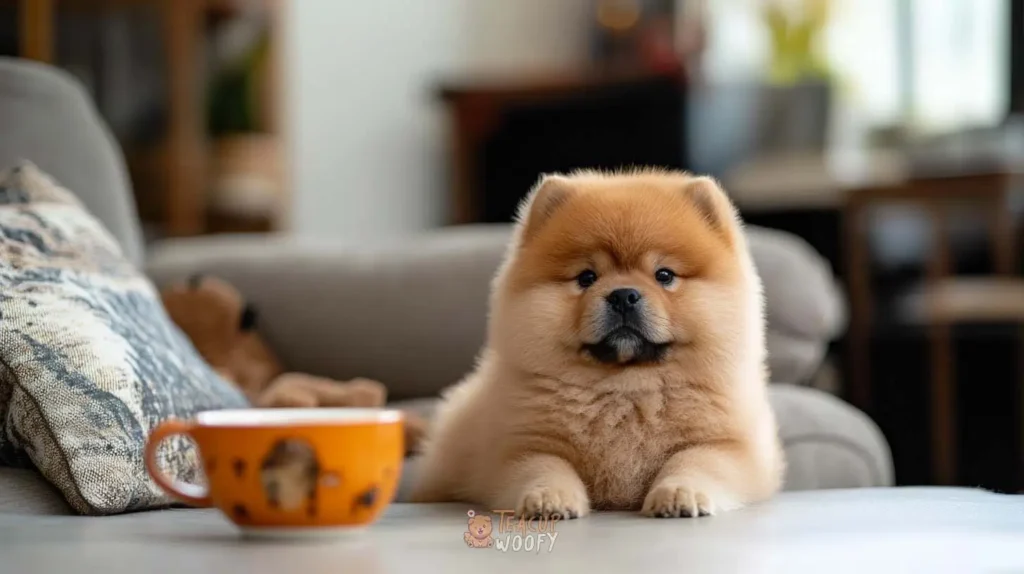
Food
Because the teacup Chow Chow is such a small dog, their food intake isn’t huge, but quality matters. On average, you’ll spend around $30 to $60 per month on food if you’re feeding high-quality small-breed kibble. If you decide to spoil your pup with fresh, raw, or specialty diets, the cost can go higher, closer to $75 per month. According to Vety, small dogs typically cost about $25 to $125 a month to feed depending on the diet.
Veterinary Care
Vet bills can sneak up on you, so it’s smart to budget monthly. Even if you’re only going for a check-up once or twice a year, when you spread out the cost, it usually comes to around $60 to $120 per month. This includes vaccinations, routine checkups, flea and tick prevention, heart worm meds, and dental care. Flea and tick treatments alone can run around $30 a month. A basic wellness visit at most clinics ranges between $50 and $250.
Grooming
Let’s be real, that fluffy double coat doesn’t just stay picture-perfect on its own. Professional grooming for a small dog like the teacup Chow Chow usually costs $30 to $90 per session. Since they need grooming every 4 to 8 weeks, you’re looking at about $30 to $80 per month on average. Brushing at home will save you money, but most owners still rely on groomers to keep the coat clean and mat-free
Diet and Nutrition for a Teacup Chow Chow
Taking care of a teacup Chow Chow’s diet is a big part of keeping them healthy. With such a small body, every bite counts. Let’s break down everything you need to know about feeding your fluffy little lion.
Monthly Food Expenses
On average, expect to spend $30 to $60 per month on high-quality kibble for small breeds. If you go for premium fresh or raw diets, it can climb to about $75 per month. Since they don’t eat large portions, quality is more important than quantity.
Essential Nutrients
A balanced teacup Chow Chow diet should include:
- Protein: Builds muscles and supports growth (look for at least 22–25% protein in puppy food, 18–22% in adult food).
- Fats: Provides energy and keeps that double coat shiny (8–12% fat for puppies, 5–8% for adults).
- Carbohydrates: For energy, ideally from whole grains or veggies, not fillers.
- Omega-3 & Omega-6 fatty acids: Keep skin healthy and reduce shedding.
- Vitamins & minerals: Calcium, phosphorus, and antioxidants are especially important for small breeds.
Best Foods for Teacup Chow Chow Puppies
- High-quality puppy kibble for small breeds (Royal Canin Small Puppy, Hill’s Science Diet Small Paws, Blue Buffalo Life Protection Puppy)
- Softened kibble or wet food for easier chewing
- Occasional boiled chicken, salmon, or pumpkin (as toppers)
How much to feed:
- Puppies need 3–4 small meals per day.
- About ¼ to ½ cup of dry food daily depending on age, spread across meals.
Best Foods for Adult Teacup Chow Chows
- Small-breed formulas like Wellness CORE Small Breed, Merrick Lil’ Plates, or Orijen Small Breed
- Lean meats (chicken, turkey, lamb, fish)
- Cooked vegetables (carrots, peas, sweet potato)
How much to feed:
- Adults do best with 2 meals per day.
- About ½ to 1 cup of kibble daily, depending on weight and activity level.
Calories per Day
- Puppies: 300–450 calories daily (spread across 3–4 meals)
- Adults: 200–400 calories daily (depending on size, activity, and metabolism)
According to the American Kennel Club, small breeds typically need 40 calories per pound of body weight per day.
Breakdown of Macronutrients
For a healthy balance, your teacup Chow Chow’s food should include:
- Protein: 22–25% (puppies), 18–22% (adults)
- Fat: 8–12% (puppies), 5–8% (adults)
- Carbohydrates: 40–50% (from whole grains, sweet potato, or rice)
- Fiber: 3–5% for good digestion
Foods You Should NEVER Feed a Teacup Chow Chow
- Chocolate
- Grapes & raisins
- Onions & garlic
- Caffeine
- Alcohol
- Cooked bones (splinter hazard)
- Xylitol (found in sugar-free gum and some peanut butter)
- Excess salt or fatty foods
Nutritional Tips for a Teacup Chow Chow
- Stick to a feeding schedule, free-feeding can lead to obesity.
- Use small-breed kibble designed for tiny mouths.
- Provide plenty of fresh water at all times.
- Introduce new foods slowly to avoid tummy upsets.
- Limit treats to 10% of daily calories.
- Consider omega-3 supplements for coat health.
Health of Teacup Chow Chows
Caring for a teacup Chow Chow goes way beyond cuddles and playtime. These little fluffballs come with unique health needs, so being prepared will save you both stress (and money!) down the road. Let’s go over the essentials.
Average Monthly Health Expenses
On average, you’ll spend around $60 to $120 per month on veterinary-related costs when averaged out. This includes routine checkups, vaccinations, flea and tick prevention, heartworm medication, and dental care. Emergencies, of course, can bump that cost way higher, which is why many owners choose pet insurance.
Overall Well-Being
A healthy teacup Chow Chow is calm, alert, and carries that signature dignified vibe. They need balanced nutrition, light exercise, mental stimulation, and regular grooming to stay happy. Because of their compact size, even small health issues can feel big, so consistency in care is key.
Common Health Problems
Like many teacup and toy breeds, they can face unique challenges:
- Dental issues (crowded teeth, gum disease)
- Luxating patella (slipped kneecap)
- Heart problems (common in smaller dogs bred for size)
- Hypoglycemia (low blood sugar, especially in puppies)
- Respiratory issues due to compressed airways
- Hip dysplasia (seen in standard Chows but possible in smaller versions too)
Energy Level
Teacup Chow Chows are moderate-energy dogs. They’re not hyper, but they do need daily activity. A couple of short walks and some indoor play usually do the trick. Too much exercise, especially jumping or rough play, can stress their joints.
Recognizing Stress in Teacup Chows
Stress shows up in little ways:
- Excessive panting or drooling
- Pacing or restlessness
- Whining or barking more than usual
- Hiding or avoiding interaction
- Changes in appetite or bathroom habits
Keeping a calm environment, offering a safe space, and sticking to routines can help ease anxiety.
Medical Care & Vet Visits
Routine vet visits should happen at least once a year for adults, and twice a year for puppies and seniors. Preventative care is huge, bloodwork, dental cleaning, and weight checks can catch problems early.
Vaccination Details
Teacup Chow Chows follow the standard small-breed vaccination schedule:
- Core vaccines: Rabies, Distemper, Parvovirus, Adenovirus
- Non-core (based on lifestyle): Bordetella (kennel cough), Lyme, Leptospirosis
- Puppy series: Typically 6–8 weeks, then boosters every 3–4 weeks until 16 weeks
- Adult dogs: Boosters every 1–3 years depending on the vaccine and your vet’s recommendation
Caring for a Senior Teacup Chow Chow
As they age (usually after 8–9 years), their needs shift:
- Switch to senior dog food with joint support and fewer calories
- More frequent vet visits (every 6 months is ideal)
- Joint supplements like glucosamine and omega-3s can help with stiffness
- Shorter, gentler walks to avoid strain
- Regular dental care, dental disease is common in older small dogs
- Lots of comfort, soft bedding, calm routines, and extra patience go a long way
Exercise
Even though they’re small, teacup Chow Chows need movement to stay healthy.
- High Energy Level: They’re not hyperactive, but they do have bursts of playful energy that need an outlet.
- Intensity: Low to moderate. Their small frames can’t handle long runs or intense workouts.
- Exercise Needs: About 20–30 minutes a day. Short walks, gentle playtime indoors, and puzzle toys for mental stimulation work well.
- Potential for Playfulness: They’ll play, but often on their own terms. Expect some zoomies, followed by long naps.
- Exercise Routine: Two short walks daily plus indoor play is ideal. Avoid stairs, jumping, or rough activities that strain their joints.
Shedding
- Shedding Level: High. Teacup Chow Chows keep the classic double coat of their larger cousins, so shedding is constant, with heavy blowouts in spring and fall.
Regular brushing (3–4 times a week) helps control fur explosions around the house.
Grooming
Grooming isn’t just about looks, it’s a health necessity for teacup Chows.
- Average Monthly Expenses: Expect $30 to $80 per month, depending on how often you visit the groomer. Professional grooming every 4–8 weeks keeps their coat healthy, while at-home brushing helps between visits.
- Hygienic Checklist:
- Brush 3–4 times a week to prevent mats
- Bathe every 6–8 weeks
- Clean eyes and ears weekly
- Brush teeth 2–3 times a week
- Trim nails every 3–4 weeks
- Benefits of Grooming: Regular grooming reduces shedding, prevents skin infections, keeps their coat shiny, and helps you spot health issues early.
- Skin Care: Their thick coat can trap dirt and moisture, so always dry thoroughly after baths. Omega-3 supplements help reduce dry, flaky skin.
- Coat Care: Use a slicker brush or undercoat rake to manage shedding. A professional groomer can trim around the paws and sanitary areas.
- Eye Care: Chows can have watery eyes. Wipe gently with a damp cloth or vet-approved wipe to prevent staining and infections.
- Ear Care: Clean ears weekly with a vet-approved ear cleaner. Look for redness or odor, which could mean infection.
- Nail Care: Small dogs’ nails grow fast! Trim every 3–4 weeks to prevent discomfort or joint stress.
Adaptability of the Teacup Chow Chow
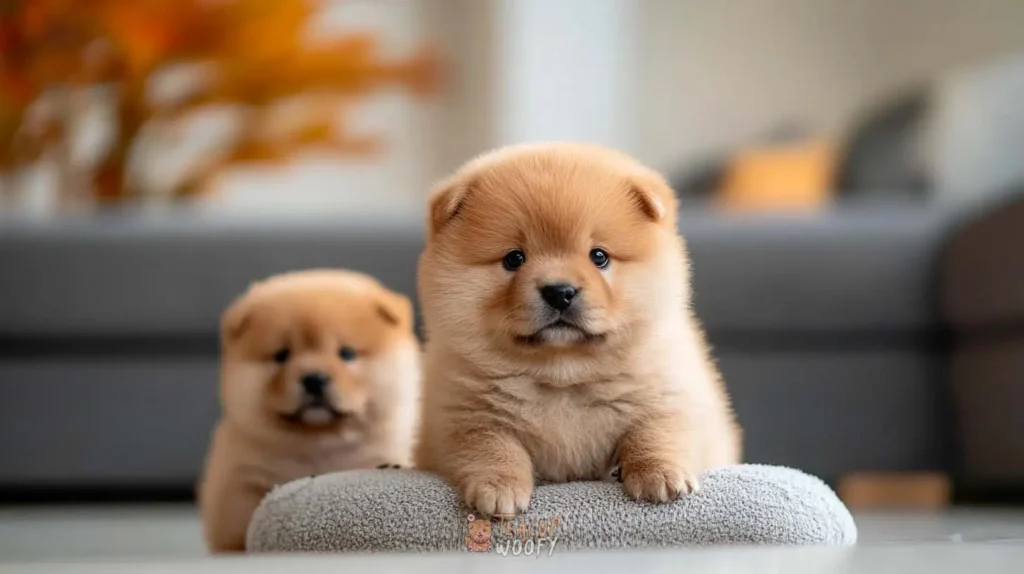
When it comes to adaptability, the teacup Chow Chow is actually pretty flexible for such a proud little fluffball. Let’s break down how well they fit into different lifestyles and environments.
Adapts Well to Apartment Living
Yes! Their small size makes them a good match for apartments or smaller homes. They don’t need huge yards or long hikes, just daily short walks and some indoor play. That said, you’ll need to stay on top of grooming because fur can pile up fast in a small space.
Tendency to Bark or Howl
Teacup Chow Chows are generally moderate barkers. They’ll let you know when someone’s at the door or when something feels “off,” but they aren’t constant yappers. With proper training and socialization, barking won’t become a problem.
Good for Novice Dog Owners
I’ll be honest here, they’re not the easiest choice for first-time owners. The teacup Chow Chow’s independent and sometimes stubborn personality can be challenging. They need a confident, patient owner who’s consistent with training. If you’re new to dogs but ready to invest time in learning, it can work, but they’re not the most “beginner-friendly” breed.
Sensitivity Level
They’re pretty sensitive to harsh tones or rough handling. Positive reinforcement works best, and they respond well to gentle but firm guidance.
Tolerates Being Alone
Better than some toy breeds. Teacup Chows can handle short periods alone since they’re not overly clingy. But, long hours alone can lead to boredom and stress. Puzzle toys or a dog sitter help if you’re away often.
Tolerates Cold Weather
Their thick double coat is basically built for the cold. Teacup Chow Chows can handle chilly weather better than most toy breeds. Just keep in mind, because they’re smaller, extreme cold still poses a risk, so don’t leave them outside too long.
Tolerates Hot Weather
Heat is trickier. That dense coat makes them prone to overheating. In hot climates, walk them early in the morning or evening, always provide fresh water, and keep them indoors with AC or fans.
All-Around Friendliness of the Teacup Chow Chow
When we talk about all-around friendliness, the teacup Chow Chow is a bit of a mixed bag. They’re loyal, sweet in their own way, but also famously independent. Let’s break it down so you know what to expect.
Best Family Dogs
Teacup Chow Chows can make wonderful family companions, but they’re not the classic “everyone’s best buddy” type. They tend to form strong bonds with one or two people and may be less affectionate with the rest of the household. Families who respect boundaries and teach kids to handle pets gently will get along beautifully with them.
Kid-Friendly
Here’s where caution is needed. They’re better with older kids who know how to be gentle. Tiny bones plus rough play equals potential accidents. For families with toddlers, I’d say wait until the kids are a little older before adding a teacup Chow Chow to the mix.
Dog-Friendly
Teacup Chow Chows can live with other dogs, but early socialization is key. Without it, they may become territorial or aloof around other pets. Introductions should always be slow and supervised to avoid conflicts.
Friendly Towards Strangers
Don’t expect them to be the social butterflies of the dog park. Teacup Chows are naturally reserved with strangers. They’re not aggressive by default, but they tend to be cautious and may take time to warm up. With proper socialization, they’ll behave politely, but you won’t get a tail-wagging “welcome wagon” every time someone visits.
Trainability of the Teacup Chow Chow
Training a teacup Chow Chow dog can be a real mix of “wow, that was smart” and “oh no, here we go again.” They’re clever pups, but their strong-willed personality means you’ll need patience and consistency.
Easy to Train
I’ll be honest, they’re not the easiest dogs to train. Teacup Chow Chows are independent thinkers, and sometimes they act like they know better than you. The good news? With positive reinforcement (lots of treats, praise, and patience), they can learn commands and routines. Harsh methods never work; they’ll just shut down or ignore you.
Intelligence
This breed is very smart, almost too smart for their own good. They can figure things out quickly but may choose not to follow through unless they feel like it. That stubborn streak is part of their charm and also the biggest challenge for new owners.
Potential for Mouthiness
As puppies, teacup Chow Chows may nip or chew during play. With proper training and chew toys, this habit usually fades. Consistency is key, don’t encourage play-biting when they’re small, or it’ll stick around.
Prey Drive
Their prey drive is moderate. They’re not as chase-happy as terriers, but small animals like squirrels or birds might trigger their instincts. Keeping them on a leash during walks is always a good idea.
Wanderlust Potential
Unlike some adventurous breeds, teacup Chow Chows don’t have a strong wanderlust instinct. They’re more likely to stay close to home, preferring comfort and familiarity. Still, secure fences and leashes are a must, curiosity can get the best of even the calmest pup.
Teacup Chow Chow Puppies
Bringing home a teacup Chow Chow puppy is like adopting a tiny cloud with a whole lot of attitude packed inside. These babies are irresistibly fluffy, with little lion-like faces that make you want to scoop them up and never let go.
Puppies’ Size
Teacup Chow Chow puppies are tiny when they first arrive. At 8 weeks old, they usually weigh only 2 to 3 pounds for males and 1.5 to 2.5 pounds for females. They can fit right in the palm of your hand! By the time they’re 3 months old, most will still only weigh 4 to 6 pounds.
- Newborns: A few ounces
- 8 weeks: 1.5 – 3 lbs
- 3 months: 3 – 6 lbs
- 6 months: 6 – 10 lbs
They’ll grow quickly in the first six months but reach full size much faster than standard Chows. By their first birthday, they’re usually only 10 to 18 pounds total.
Puppies’ Images
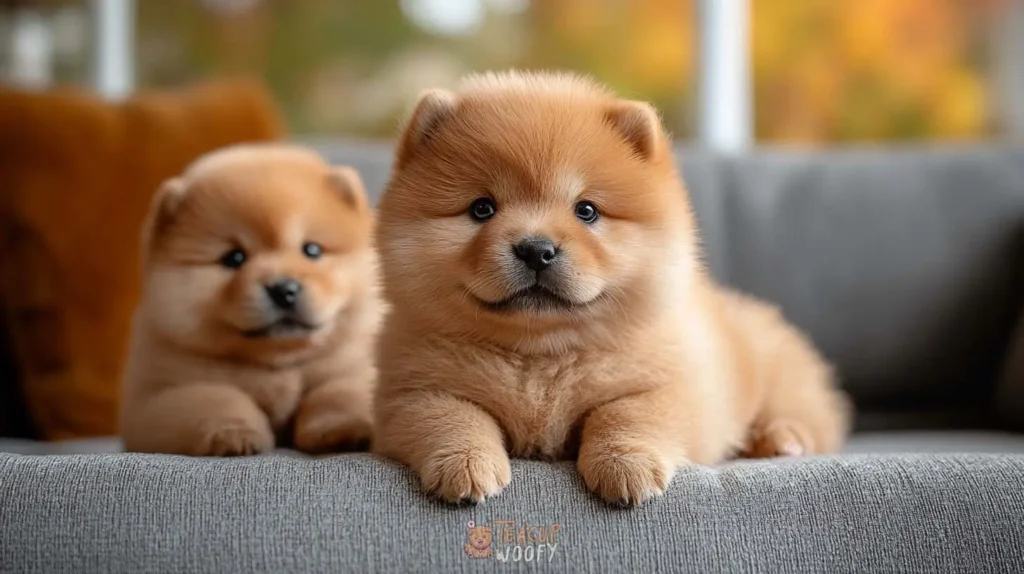
Male vs Female Teacup Chow Chows
When you’re deciding between a male or female teacup Chow Chow, the differences aren’t massive, but there are a few things to know that can help you pick the right fit for your family. Both genders are loyal, protective, and full of that classic Chow dignity, but their personalities and growth can vary just a bit.
Size Differences
- Males: Typically a little larger, weighing around 12 to 18 pounds when full-grown, and standing 9 to 11 inches at the shoulder.
- Females: Slightly smaller, usually 10 to 16 pounds and about 8.5 to 10 inches tall.
Both are tiny compared to a standard Chow, but males often look a touch stockier.
Temperament
- Males: Can be more outgoing and playful, though sometimes a bit stubborn when it comes to training. They may also be more protective of their territory.
- Females: Often more independent and reserved. Some owners find females a little easier to train since they tend to focus better, but they can also be moodier.
Trainability
Neither gender is a “walk in the park” to train, both need consistency, patience, and positive reinforcement. Males might test boundaries more often, while females may quietly ignore commands if they’re not in the mood.
Which Is Better for Families?
- Males: Great if you want a playful little companion who enjoys interaction.
- Females: Often a better match for owners who prefer a calmer, more independent dog.
What to Know Before You Buy or Rehome a Teacup Chow Chow
Before you rush to bring home a teacup Chow Chow, there are a few things every future dog parent needs to know. These pups may look like living teddy bears, but owning one is a big commitment, both financially and emotionally.
1. Be Wary of “Teacup” Labels
The teacup Chow Chow isn’t officially recognized by the American Kennel Club (AKC). Breeders create them by pairing the smallest Chows or mixing with smaller breeds. This can lead to health problems, so always research the breeder carefully. If someone is advertising “teacup chow chows for sale” at bargain prices, it’s usually a red flag.
2. Health Screening Is Non-Negotiable
Teacup breeds are prone to health conditions like:
- Hip and joint issues
- Dental crowding
- Heart problems
- Hypoglycemia in puppies
Ask for proof of vet checks, genetic testing, and health certificates. Reputable breeders will be transparent about potential risks.
3. Cost Expectations
These pups don’t come cheap. A teacup Chow puppy for sale often costs anywhere from $2,500 to $5,000 USD, depending on the breeder, color, and lineage. Adoption fees, on the other hand, can range from $150 to $400 USD, though finding a teacup through rescue is rare.
4. Grooming & Care Needs
With that thick double coat, grooming is a must. You’ll need to budget time and money for regular brushing and professional grooming. Plus, these dogs need a balanced diet, vet visits, and a safe environment, not too hot, not too cold.
5. Lifestyle Fit
Teacup Chow Chows do well in apartments and smaller spaces, but they’re not a “starter dog” for everyone. They can be stubborn, independent, and aloof with strangers. If you’re a first-time dog owner, be ready for patience and consistency in training.
6. Adoption vs Buying
- Adoption: More affordable, saves a life, but you may not always find a teacup size available.
- Buying: Gives you the option to choose age, size, and sometimes pedigree, but make sure the breeder is ethical. Avoid puppy mills or online sellers that can’t show you where the pup was raised.
10 Facts About the Teacup Chow Chow
If you’re smitten with the teacup Chow Chow, you’re not alone. These little fluffballs are full of surprises, quirks, and a history that makes them stand out. Here are ten fun and important facts every potential owner should know.
- 1. Ancient Roots: The Chow Chow breed itself dates back over 2,000 years in China. They were once guard dogs for palaces and hunting companions of emperors. The teacup variety is a modern twist on this ancient breed.
- 2. Not Officially Recognized: The teacup Chow Chow isn’t recognized by major kennel clubs like the AKC. It’s created by breeding smaller Chows together or mixing with toy breeds.
- 3. That Famous Blue-Black Tongue: Just like their standard-sized cousins, teacup Chow Chows have the iconic blue-black tongue, one of the most unique features in the dog world.
- 4. Teddy Bear Look: With their fluffy coats and round faces, teacup Chow Chows often get mistaken for living teddy bears. They’re Instagram stars waiting to happen!
- 5. Small But Might: Even though they weigh only 10–18 pounds, they carry themselves with the same pride and dignity as a full-sized Chow. Don’t underestimate their confidence.
- 6. Coat Color: They come in the same stunning colors as standard Chows, red, cream, black, cinnamon, and blue. The red and cream varieties are especially popular.
- 7. Loyal but Independent: These pups are devoted to their families, but they’re not clingy lapdogs. Expect quiet loyalty, not constant neediness.
- 8. Grooming Is Serious Business: With a thick double coat, they shed year-round and require frequent brushing plus regular professional grooming.
- 9. Reserved With Strangers: Teacup Chow Chows tend to be cautious and aloof around strangers. They’re excellent little watchdogs but rarely aggressive if socialized properly.
- 10. Pricey Companions: Because of their rarity, teacup Chow Chow puppies for sale often range between $2,500 and $5,000 USD. Factor in grooming and vet care, and they’re definitely an investment.
Summary: Teacup Chow Chow
The teacup Chow Chow is a tiny twist on one of the world’s oldest and most dignified breeds. With their fluffy coats, iconic blue-black tongues, and teddy bear looks, they’ve become a dream dog for city dwellers and families who want the charm of a Chow in a pint-sized package.
These pups typically weigh 10 to 18 pounds and stand 8.5 to 11 inches tall, making them suitable for apartment living. They’re loyal, protective, and calm, but they also carry that signature Chow independence. While they bond deeply with their families, they can be reserved with strangers and need patient, consistent training.
Caring for a teacup Chow Chow comes with responsibilities: regular grooming for their double coat, a balanced diet, routine vet care, and protection from extreme heat. They’re not the best pick for first-time dog owners or families with very young kids, but in the right home, they thrive as loving, low-energy companions.
Yes, they’re expensive, with puppies often priced between $2,500 and $5,000, and their monthly upkeep can run $120 to $260 depending on food, grooming, and health needs. But for those ready to commit, the reward is a loyal, regal little lion dog who’ll bring years of quiet devotion and charm.
Frequently Asked Questions:
Are teacup Chow Chows hypoallergenic?
No, teacup Chow Chows are not hypoallergenic. They have thick double coats and shed heavily year-round.
How long do teacup Chow Chows live?
On average, they live 9 to 12 years, though good diet, exercise, and regular vet care can extend their lifespan.
How much does a teacup Chow Chow puppy cost?
A teacup Chow Chow puppy usually costs between $2,500 and $5,000, depending on the breeder, color, and health guarantees.

